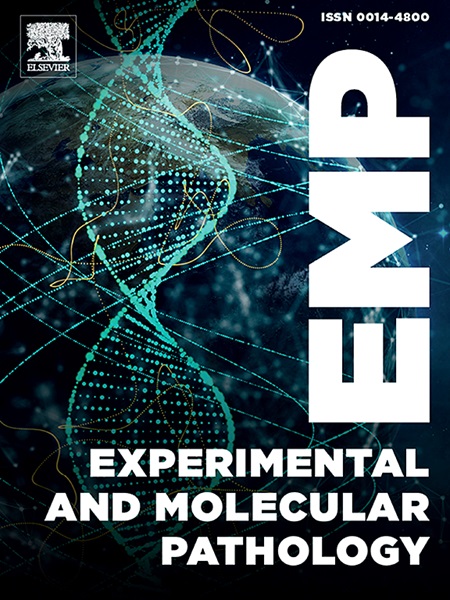Twenty-eight-day perfluorooctanoate exposure does not affect immune cell populations in naïve mice
IF 3.7
4区 医学
Q2 PATHOLOGY
引用次数: 0
Abstract
Perfluorooctanoate (C7F15CO2−, PFOA) is a perfluorinated compound widely used in the production of industrial products, such as non-stick cookware and firefighting foams. Although its production has been phased out in the United States, PFOA remains prevalent in the environment due to its persistence and resistance to degradation. As a result, trace levels of PFOA is detectable in water, soil, biota, and the general population. Environmental and toxicological concerns have emerged due to potential health risks associated with PFOA exposure, including effects on the immune system. Basic underlying knowledge gaps exist for potential effects of PFOA on baseline immune cell maintenance in the absence of overt liver hypertrophy. In this study, we assessed the immune-related effects of 28-day daily PFOA exposure in adult naïve mice, using doses of 20 ng/kg/day, 200 ng/kg/day, 2 μg/kg/day, and 40 μg/kg/day, resulting in mean serum PFOA concentrations of non-detectable, 6.979 ng/mL, 80.03 ng/mL, and 1773 ng/mL respectively, representative of levels seen in the general human population (∼1.5 ng/mL), community-exposed residents (∼225 ng/mL), and occupational workers (∼2000 ng/mL). Evaluation of immune cell populations in bone marrow, thymus, spleen, liver, and lymph nodes, along with serum antibodies indicate that 28 days of PFOA exposure had no effect on proportion and number of immune cell populations nor serum antibodies, except for a slight decrease in serum IgE at the highest dose. By contrast, mice receiving CTX, a known immune suppressant, exhibited a wide array of biological responses, which were absent from PFOA-treated mice. These findings contribute to understanding the potential immune effects of environmentally relevant PFOA exposure.
接触全氟辛酸28天不会影响naïve小鼠的免疫细胞群
全氟辛酸盐(C7F15CO2−,PFOA)是一种全氟化合物,广泛用于工业产品的生产,如不粘锅和消防泡沫。尽管PFOA的生产在美国已被逐步淘汰,但由于其持久性和抗降解性,PFOA在环境中仍然普遍存在。因此,在水、土壤、生物群和一般人群中都可以检测到痕量的全氟辛酸。由于接触全氟辛酸可能带来健康风险,包括对免疫系统的影响,环境和毒理学问题已经出现。在没有明显肝肥大的情况下,PFOA对基线免疫细胞维持的潜在影响存在基本的潜在知识空白。在这项研究中,我们评估了成年naïve小鼠每天暴露28天的PFOA的免疫相关影响,剂量分别为20 ng/kg/day, 200 ng/kg/day, 2 μg/kg/day和40 μg/kg/day,结果血清PFOA平均浓度分别为6.979 ng/mL, 80.03 ng/mL和1773 ng/mL,代表了一般人群(~ 1.5 ng/mL),社区暴露居民(~ 225 ng/mL)和职业工人(~ 2000 ng/mL)的水平。对骨髓、胸腺、脾脏、肝脏和淋巴结的免疫细胞群以及血清抗体的评估表明,接触PFOA 28天对免疫细胞群的比例和数量以及血清抗体没有影响,除了在最高剂量时血清IgE略有下降。相比之下,接受CTX(一种已知的免疫抑制剂)的小鼠表现出广泛的生物反应,这在pfoa治疗的小鼠中是不存在的。这些发现有助于了解与环境相关的全氟辛酸暴露的潜在免疫效应。
本文章由计算机程序翻译,如有差异,请以英文原文为准。
求助全文
约1分钟内获得全文
求助全文
来源期刊
CiteScore
8.90
自引率
0.00%
发文量
78
审稿时长
11.5 weeks
期刊介绍:
Under new editorial leadership, Experimental and Molecular Pathology presents original articles on disease processes in relation to structural and biochemical alterations in mammalian tissues and fluids and on the application of newer techniques of molecular biology to problems of pathology in humans and other animals. The journal also publishes selected interpretive synthesis reviews by bench level investigators working at the "cutting edge" of contemporary research in pathology. In addition, special thematic issues present original research reports that unravel some of Nature''s most jealously guarded secrets on the pathologic basis of disease.
Research Areas include: Stem cells; Neoangiogenesis; Molecular diagnostics; Polymerase chain reaction; In situ hybridization; DNA sequencing; Cell receptors; Carcinogenesis; Pathobiology of neoplasia; Complex infectious diseases; Transplantation; Cytokines; Flow cytomeric analysis; Inflammation; Cellular injury; Immunology and hypersensitivity; Athersclerosis.

 求助内容:
求助内容: 应助结果提醒方式:
应助结果提醒方式:


